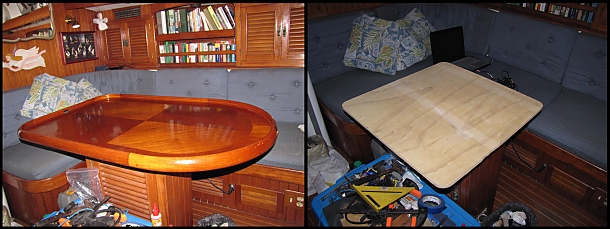Thinking Ahead
/Recently while chatting with a young couple who want to go cruising someday, they commented on how much advanced planning or organization was necessary to live on a boat full time. I got to thinking about that, because some things are definitely well-planned in advance and if it's important, it goes on a list.
Fuel, food, water and propane probably top the “thinking ahead” list just before leaving for a passage. These are the basic biggies for advanced planning, but there seem to be a zillion other little things to think about. The assumption is, of course, that the boat is shipshape and ready to go before we even consider heading out.
Spare boat parts usually fall into David's bailiwick. How many spare parts are enough? (This will be a Blue View blog post on its own.) Keeping track of what we've used and what needs to be purchased is a joint effort. We keep a running list in a special notebook of ordering details and specifics on just about everything in the boat from oil filters and zinc anodes to spare starters and alternators. There are so many systems on the boat, keeping track of all the spare parts and their locations can be a challenge (another future blog post?). One fellow we met said “Why keep spare parts aboard when you can order them and have them shipped anywhere in the world?”. He obviously never spent time in the Patagonian Canals or crossed an ocean when something broke and needed replacing … immediately.
While we're on the subject of parts, project planning requires that we have all supplies necessary in advance of beginning the project. Whether it be varnish and brushes for brightwork maintenance or epoxy, timber and paint for planned deck repairs, everything has to be aboard before the project is begun because we can't always assume what we need will be available in our ports of call. Repairing the decks and doing a yearly varnish job in Vanuatu were perfect examples of this.
There are other little things to consider in advance like making sure the laundry gets done at the last possible minute before we leave because I never know where and when I might have the chance to do it again other than by hand. Or, if we plan to use the freezer, defrosting it well enough in advance, so that it's ice-free and back down to temperature in time for everything to be frozen solid before we leave, but not so far in advance that it's frosted over again.
Thinking ahead might not have anything to do with a passage, like figuring out if something will fit in the boat before we buy it. One example was our Franken-mattress. We knew we'd have to modify it in order to get it through the companionway. What we didn't think about was whether all the sheets we currently had would fit it once it was modified. The new mattress is considerably thicker than the old one. We lucked out because the sheets we have accommodated the new mattress. Otherwise, we would have had to reluctantly purchase new bed linens (called manchesters in NZ and Australia, by the way).
Minor issues like whether a turkey will fit into our little oven or whether something will fit into the fridge can seem major if you've already bought the turkey and have no place to put it. It's important to have enough of everything, but it's a problem when there's too much. Even though we have adequate stowage space, there's only so much room available on the boat. No building an extra tool shed or renting extra storage space; it's all got to fit.
Anything requiring lots of water needs to be done while we're at a dock. Whether it be washing down the boat, making a batch of brew or canning (preserving), it needs to be done while we have ample fresh water available. Same goes for power-intensive projects. When we're generating our own power, it's more difficult to get a sewing project done or for David to be drilling or using power tools. In an emergency, no problem, but using up power just to complete a casual chore, not so much.
While in larger ports where medical care is available and accessible, we usually plan our dental visits, eye exams and whatever else is required. Once we're at sea or in remote little towns or islands, we've missed our window of opportunity.
Also while in port, we make the most of internet availability, doing research on places we'll visit, downloading maps and other cruiser's notes on ports along the way, sending photos, etc. Though we have SailMail at sea, it only supports text email (not internet) and we can't send or receive attachments.
Then there's planning for holidays. Sounds frivolous, I guess, but it's really not if you'll be at sea for a holiday and you want something special on hand. We've been at sea on Thanksgiving, Easter, for birthdays and several other holidays. If I want to prepare a special meal or bake something for the occasion, making sure that I've got all the ingredients and accompaniments aboard are important.
What about thinking ahead to birthdays and holidays back in the States or bills that need to be paid. If we know we'll be out of internet range, we make sure all gifts, cards and definitely credit card payments are scheduled in advance. Having internet, by the way, has been a Godsend when it comes to ordering gifts on line, sending e-cards and sending electronic checks and payments.
Probably one of the most difficult aspects of planning ahead is where we intend go next. It seems that we rarely keep to a plan. If we did, we would have completed at least two circumnavigations by now instead of working on completion of our first. There's thinking ahead and then there's actually doing what you thought about.













